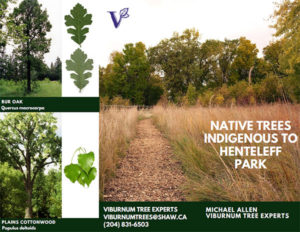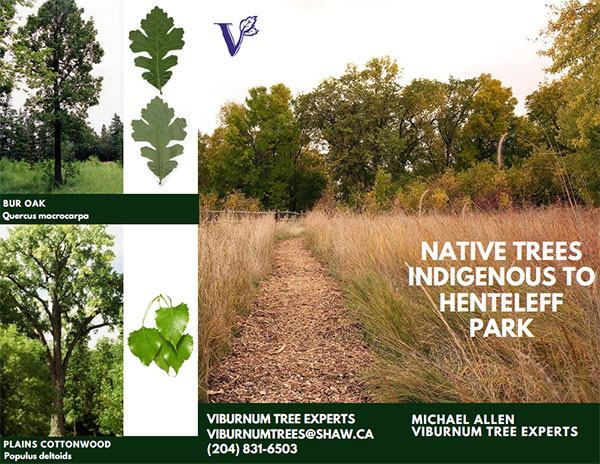Green Ash (Fraxinus pensylvanica var. subintegerrima)
In addition to the elms, green ash is and continues to be a very common planted tree on street boulevards. In recent years, cultivated and hybrid varieties of this tree, along with the northern black ash, have now largely replaced the pure green ash tree. It still makes a great tree to plant for naturalized areas.
Trembling Aspen (Populus tremuloides)
Trembling aspen is the most common deciduous tree in Manitoba as well as in Canada. Typically, younger aspen trees have a chalky powder on the bark that prevents the thin bark from desiccation when exposed to the heat and rays of the sun. Although aspen is a relatively short lived tree, the root systems can live for a long time. The tree propagates itself by sending up shoots from its roots especially after a major disturbance such as fire. The oldest known root systems of any trees in the world are believed to be aspens growing in Fishlake National Forest in Utah. They are about 80,000 years old.
Basswood (Tilia americana)
Basswood has the lowest density of wood of any of our trees; although the aspen is a very close second. The wood is easily carved and is especially used in making bird sculptures. The tree produces fragrant flowers with pollen that attracts pollenating insects. In Winnipeg, there are specimens that exceed 100 feet in height near the Assiniboine River. The tree is also called American linden,
White Birch (Betula papyrifera)
White birch is probably the most recognizable tree to the average person owing to its very obvious papery white bark. This tree and especially its bark has been used for centuries by aboriginal peoples and early European explorers for building canoes. These canoes were most useful for travelling and exploring the nation’s waterways. As well, birch bark was used to make bark containers to collect, store, cook and consume food or other products; make hunting and fishing gear; musical instruments, decorative fans, and even children’s sleds and other toys. This tree is slowly disappearing from our landscapes because of the voracious feeding of the bronze birch borer beetle. This pest cannot be stopped.
Plains Cottonwood (Populous deltoides)
Plains cottonwood is a sub-species of the eastern cottonwood in the poplar family. This is the largest North American deciduous or leaf dropping tree. It can grow up to 130 feet high. Cottonwoods also live much longer than any other poplar tree. Typically it grows in low lying areas that are not prone to become flooded with stagnant water. The species has separate male and female trees. The female tree is much maligned owing to its periodic production of voluminous masses of cotton seed fluff.
American Elm (Ulmus americana)
The tree has a characteristic ‘Y’ shaped or ‘umbrella’ profile that most Manitobans recognize. This was once the most common boulevard and park tree in Manitoba. In the past, furniture makers favoured this tree because it’s very hard wood. Its presence has drastically declined due to Dutch elm disease. There is no approved control for this disease even after many dozens years of active research. Elm is the most tolerant indigenous tree for urban conditions. Generally it is not susceptible to the disease in its first 25 years. It should be used for more naturalization projects as it is easy to establish. Planting this elm near rivers and streams is still recommended.
Hackberry (Celtis occidentalis)
In Manitoba, there is a natural variety of this tree that has been botanically named Delta. The tree is indigenous to the south shore of the Delta marsh region of Lake Manitoba. It is not normally a tall growing tree, but interestingly, in that region, there was a heritage tree that was about 70 feet high. Wind damage took half the tree down and it was eventually removed. There are no indigenous hackberry trees in Henteleff Park, but the species is one of the most versatile trees for establishing tree cover in urbanized and naturally occurring areas in southern Manitoba. The tree’s strong warty bark provides interest and uniqueness to our indigenous provincial trees.
Manitoba Maple (Acer negundo)
This is one of the most common deciduous trees found along Manitoba waterways. Farmers have planted this tree for shelter especially along their farm roads and in their fields. This is the only North American maple having multiple leaflets instead of a single leaf. In Manitoba, there can be 3 leaflets or less commonly, 5 leaflets. The tree can be tapped in the early spring for its sap and assuming there is sufficient quantity, can be boiled down to make it a great tasting maple syrup. It does, however take quite a few tapped trees to make the syrup in any reasonable quantity. The whitish wood is similar to the wood of the common evergreen conifer shrub – boxwood, which is why its alternate name is box elder in the United States.
Bur Oak (Quercus macrocarpa)
Bur oak is typically the oldest living tree in Manitoba. It is commonly recognized by most people by the unique shape of its lobed leaves and by its production of acorns from time to time. Of all of our trees, the wood of oaks is the hardest, closely followed by the American elm. Its ring porous wood – quite visible to the eye – makes exceptionally fine, dense hardwood furniture. In Manitoba, these oaks are threatened by the invasion of the two-lined chestnut borer beetle which is related to the bronze birch borer. Similar to birch, the trees are gradually killed from the top down. There is no approved control for this pest in Manitoba.
Balsam Poplar (Populous balsamifera)
This the third most common indigenous poplar in our region, although it is nowhere near as abundant as trembling aspen. This is the largest deciduous tree in in the northern and western parts of its range in North America. In some areas, it can grow quite close to the Arctic Ocean. The species often grows in dense stands just like other poplars. It also produces sucker shoots from its roots. In our area, a consistent identifying leaf feature is the rust spots on the back side of the leaf. The spots are produced by the leaf’s unique excretory glands.
Nannyberry (Viburnum lentago)
Until recently this species of Viburnum existed in the park near the Red river in its shrub form. It is the newest tree addition to Henteleff Park. Several tree forms have been recently planted near the interpretative centre. Nannyberry can exist as a single trunk and/or multiple trunk tree, or it can be a large shrub. It is a fragrant flowering tree with multiple clusters of creamy white blooms. The leaves usually turn a burgundy-red colour in the fall. Its prolific quantity of blue berries in the fall makes it a favourite food source for many bird species.


